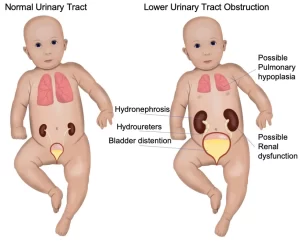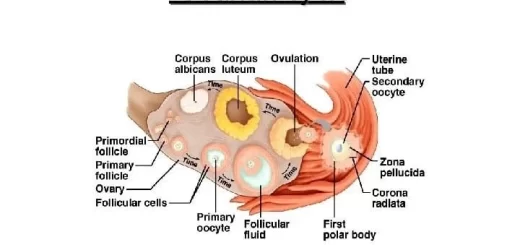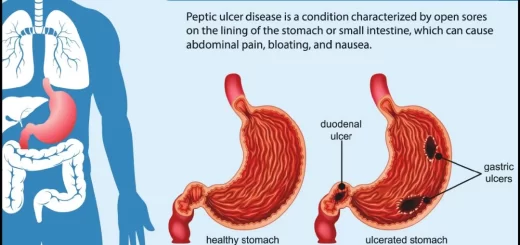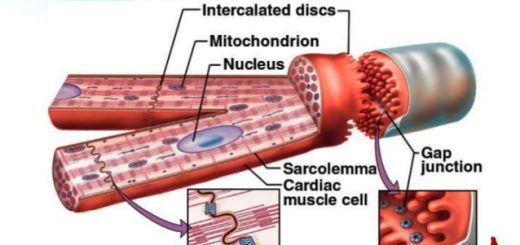Urinary tract obstruction symptoms, causes and obstructive lesions of urinary tract
Urinary obstruction is a common cause of renal dysfunction and it is important to recognize because many of its causes are treatable, Obstruction may be sudden or insidious, partial or complete, unilateral or bilateral; It may occur at any level of the urinary tract from the urethra to the renal pelvis, It can be caused by intrinsic lesions of the urinary tract or extrinsic lesions that compress the ureter or urethra.
Urinary tract obstruction
The obstruction may be:
- Acute obstruction: sudden and complete obstruction leads to rapid cessation Of urine production due to increasing intraluminal pressure transmitted back to proximal convoluted tubules. If both kidneys are involved acute renal failure quickly follows.
- Chronic obstruction: i.e. insidious, progressive partial obstruction or intermittent complete obstruction. It is more common and leads to hydronephrosis.
Obstructive lesions of the urinary tract
The commonest causes:
- Congenital anomalies.
- Urinary stones.
- Tumors.
- Inflammation.
- Functional disorders.
- Foreign bodies.
- Benign prostatic hyperplasia.
- Pregnancy, uterine prolapse.
Complications
- Increased susceptibility to infection.
- Increased susceptibility to stone formation
- Hydronephrosis.
Hydronephrosis
Definition: permanent dilation of the renal pelvis and calyces associated with progressive atrophy of the kidney parenchyma due to chronic (partial or intermittent complete) obstruction to urine outflow. It may be unilateral or bilateral.
Etiology
A. Unilateral Obstruction
Obstruction of one side is due to pathologic processes above the urinary bladder.
The causes include:
- Causes at the renal pelvis; such as calculi especially staghorn stones, tumors of the renal pelvis, and ureteropelvic stricture.
- Causes in the ureter, which may be intrinsic within the ureteric lumen or extrinsic (compressing from outside).
- Intrinsic factors such as ureteric calculi, ureteric tumors; chronic fibrosis as in the case of bilharziasis, and blood clots.
- Extrinsic factors compressing the ureter from outside as pregnancy. pelvic tumors and retroperitoneal fibrosis.
B. Bilateral hydronephrosis
Obstruction of both sides at the level of the urinary bladder, bladder outlet or urethra.
The causes include:
- Causes in the urinary bladder as chronic cystitis with fibrosis (as in bilharziasis), bladder stone or tumor obstructing the urethral opening or neurogenic bladder due to spinal cord damage as in DM.
- Causes in the urethra and bladder outlet which may be intrinsic or extrinsic.
- Intrinsic factors cause posterior urethra valve and urethral stricture following urethritis especially due to gonorrhea infection, urethral tumors or stones.
- Extrinsic factors compressing the urethra or bladder outlet as pelvic neoplasms in the uterine cervix or rectum, enlarged prostate as prostatitis; prostatic hyperplasia or prostatic carcinoma.
Morphology
- The kidney is slightly or massively enlarged.
- The renal pelvis and calyceal system are dilated compressing the renal parenchyma.
- Later the kidney is transformed into with thin-walled cystic structure full of urine striking. parenchymal atrophy.
- Depending on the level of obstruction, one or both ureters also may be dilated (hydroureter).
Clinical features
- Unilateral hydronephrosis: may remain silent for long periods (asymptomatic) since the unaffected kidney can maintain the adequate renal function.
- Bilateral hydronephrosis: presents with hypertension with progressive loss of renal functions.
Complications:
- Pyonephrosis: May occur due to superadded infection. The kidney in such cases is transformed into a bag full of pus. The renal pelvis and calyces show dirty yellow even slag exudate.
- Stone formation due to urine stagnation.
- Renal failure (in case of bilateral hydronephrosis).
You can subscribe to science online on Youtube from this link: Science Online
You can download Science Online application on Google Play from this link: Science Online Apps on Google Play
Urinary bladder structure, function, Control of micturition by Brain & Voluntary micturition
Urinary passages function, structure of Ureter, Urinary bladder & Uvulae vesicae
Control of water balance in your body, Regulation of volume & osmolality of Body fluids
Urine formation, Factors affecting Glomerular filtration rate, Tubular reabsorption & secretion
Histological structure of kidneys, Uriniferous tubules & Types of nephrons
Functions of Kidneys, Role of Kidney in glucose homeostasis, Lipid & protein metabolism
Physical properties of urine, Tests to evaluate kidney function & Normal constituents of urine




